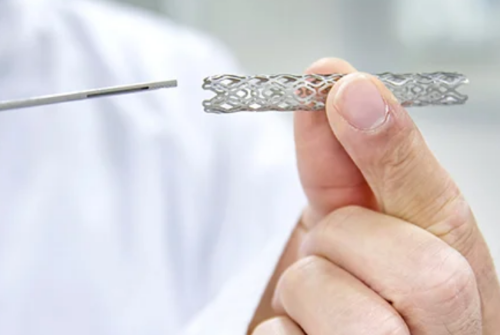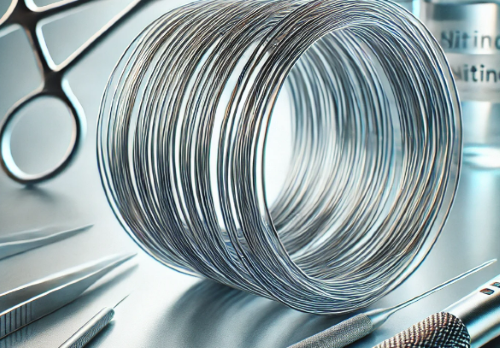
Introduction
Among the many breakthroughs, Nitinol stands out as a revolutionary material that has reshaped various aspects of medicine, particularly in devices and tools that require flexibility, durability, and biocompatibility. Often referred to as “Nitinol Wire” when produced in extremely fine wire forms, this alloy is renowned for its shape memory and superelastic properties, making it indispensable in orthodontic rings, heart stents, and surgical instruments.
Understanding Nitinol
Nitinol is a nickel-titanium alloy, known for its two distinctive properties: shape memory and superelasticity. Shape memory refers to the material’s ability to “remember” its original shape after being deformed, and it returns to that shape when exposed to a specific temperature. Superelasticity allows Nitinol to undergo significant deformation and recover its original form without permanent damage.

These properties arise from the phase transformation between two different crystal structures, austenite and martensite. At lower temperatures or when deformed, Nitinol exists in its martensitic phase, which is easily shapeable. Upon heating or relieving the mechanical load, it transitions to its austenitic phase, regaining its pre-set shape. This unique behavior makes Nitinol an exceptional material in various medical applications.
Related reading: Nitinol – Amazing Shape Memory Alloy
Orthodontic Rings: Nitinol’s Impact on Dentistry
In orthodontics, Nitinol has become a staple for braces and other dental devices, especially in the form of orthodontic rings and archwires. Traditional materials used in braces often apply inconsistent pressure over time, requiring frequent adjustments. Nitinol, however, has transformed this by offering a more consistent, gentle force over an extended period due to its shape memory and superelastic properties.
When used in orthodontic rings, Nitinol can maintain constant pressure on teeth, allowing them to move more gradually and efficiently. The material’s ability to return to its original shape after deformation helps ensure continuous pressure, even as the teeth shift. This not only reduces the number of adjustments needed but also makes the treatment more comfortable for patients.
Moreover, Nitinol’s durability and resistance to fatigue ensure that orthodontic devices made from this material are long-lasting and reliable, enhancing the overall effectiveness of dental treatments.
Heart Stents: Revolutionizing Cardiovascular Health
One of the most life-saving applications of Nitinol is in heart stents, devices used to treat blocked or narrowed arteries in patients with cardiovascular disease. The superelasticity of Nitinol allows these stents to be compressed into a small size for easy insertion into blood vessels, and once inside the body, the stent expands to its original shape, restoring blood flow through the artery.

[1]
This ability to change shape in response to body temperature is a game-changer in cardiovascular interventions. Traditional stents often require balloon expansion, which can sometimes cause damage to the artery wall. Nitinol stents, on the other hand, expand naturally at body temperature, minimizing the risk of complications during the procedure.
Additionally, Nitinol stents are highly flexible, allowing them to conform to the natural curves and movements of the arteries. This adaptability reduces the chances of artery re-narrowing (restenosis), making them highly effective in long-term cardiovascular treatments.
Surgical Instruments: Precision and Flexibility
Nitinol has also made significant strides in the realm of surgical instruments. Its unique properties are particularly valuable in minimally invasive surgeries, where precision and flexibility are paramount. Instruments made from Nitinol, such as guidewires, retrieval devices, and clamps, can navigate the body’s complex anatomy with ease, returning to their original shape after bending or twisting.
For example, in laparoscopic or robotic surgeries, where small incisions and precise movements are required, Nitinol’s superelasticity allows surgeons to work in confined spaces without sacrificing control. The material’s ability to bend and flex while maintaining strength ensures that these instruments can perform intricate procedures while minimizing tissue damage.
Nitinol is also commonly used in surgical staples and clamps, where its shape memory helps devices secure tissue and blood vessels effectively. These tools can be compressed for insertion and then expand or contract to provide the necessary pressure or support once inside the body.
Biocompatibility and Durability: Why Nitinol Succeeds
Beyond its mechanical properties, Nitinol’s biocompatibility makes it an ideal material for medical applications. Its inert nature minimizes the risk of adverse reactions or rejection by the body, making it safe for long-term use in implants and devices. Nitinol’s resistance to corrosion is another significant advantage, particularly in environments like the human body, where exposure to fluids and varying pH levels could degrade less robust materials.
Furthermore, Nitinol’s durability ensures that medical devices made from this alloy are long-lasting and reliable. Whether in orthodontic treatments that span years, stents designed to last a lifetime, or surgical instruments used in demanding environments, Nitinol’s ability to withstand fatigue and repeated use makes it an invaluable asset in modern medicine.
Conclusion
Nitinol Wire, with its shape memory, superelasticity, and biocompatibility, has transformed various medical fields. From orthodontic rings that provide gentle and consistent pressure to heart stents that save lives through minimally invasive procedures, Nitinol has become an essential material in modern healthcare. For more information, please check Advanced Refractory Metals (ARM).
Reference:
[1] British Heart Foundation (2024, September 10). How do stents work? Retrieved September 10, 2024, from https://www.bhf.org.uk/informationsupport/heart-matters-magazine/medical/how-do-stents-work

